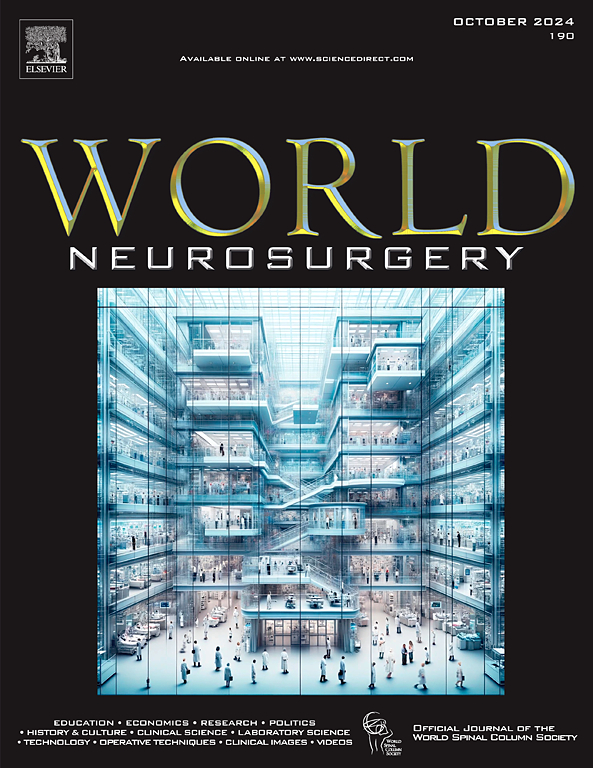Surgical Management of Unstable Atlas Fractures: A Single Institutional Retrospective Review with Comparison of Occipitocervical and Atlantoaxial Fusion Outcomes
IF 1.9
4区 医学
Q3 CLINICAL NEUROLOGY
引用次数: 0
Abstract
Background
Atlas fractures represent 25% of craniocervical injuries, most common in elders. Unstable first cervical vertebra fractures with lateral mass displacement require surgical fixation. Options include atlantoaxial fusion (AAF) or occiput-cervical fusion (OCF), each have their respective merits and detractors. Here, we compare the clinical and neurological outcomes of patients with unstable atlas fractures treated with AAF and OCF.
Methods
A retrospective review of patients with unstable atlas fractures that underwent either AAF or OCF between 2005 and 2023 was performed. Demographics, clinical characteristics, radiographic parameters, and outcomes were collected. Cervical sagittal balance was measured by O-second cervical vertebra (C2 or axis) angle, C2-7 lordosis, and C2-7 sagittal vertical axis (SVA).
Results
Forty-four patients with unstable atlas fractures were included (25 underwent AAF and 19 OCF). The median age was 73 years, and 52% were male. Demographics, mechanism of injury, and other clinical characteristics were similar. Landell's type 2 atlas fractures and lateral mass displacement were significantly in the OCF group. Median number of levels was significantly greater in the OCF group (3 vs. 2 in AAF, P=<0.001). C2-7 lordosis was less in OCF versus AAF (P = 0.045). SVA was less in the AAF group versus OCF (P = 0.044). Cervical SVA was decreased 4.5 mm in average in the AAF group versus 5.2 mm increase in OCF (P = 0.040). There were no significant differences in the rates of postoperative complication, surgical revision, or neurologic function.
Conclusions
OCF results in significant loss of lordosis and increase in cervical SVA relative to AAF, which may impact long-term quality of life and disability not directly measured in this study.
不稳定寰椎骨折的外科治疗:枕颈融合和寰枢融合结果比较的单一机构回顾性回顾。
背景:寰椎骨折占颅颈损伤的25%,最常见于老年人。伴有侧块移位的不稳定C1骨折需要手术固定。选择包括寰枢融合(AAF)或枕颈融合(OCF),每个都有各自的优点和缺点。在这里,我们比较了AAF和OCF治疗不稳定寰椎骨折患者的临床和神经预后。方法:回顾性分析2005-2023年间不稳定寰椎骨折行AAF或OCF的患者。收集了人口统计学、临床特征、影像学参数和结果。通过O-C2角度、C2-7前凸和C2-7矢状垂直轴(SVA)测量颈椎矢状平衡。结果:44例不稳定寰椎骨折患者(25例行AAF, 19例行OCF)。中位年龄73岁,52%为男性。人口统计学、损伤机制和其他临床特征相似。OCF组Landell 2型寰椎骨折和侧块移位明显。OCF组的中位水平数显著高于AAF组(3个水平,而AAF组为2个水平,p=结论:相对于AAF, OCF导致明显的前凸丧失和颈椎SVA增加,这可能影响本研究未直接测量的长期生活质量和残疾。
本文章由计算机程序翻译,如有差异,请以英文原文为准。
求助全文
约1分钟内获得全文
求助全文
来源期刊

World neurosurgery
CLINICAL NEUROLOGY-SURGERY
CiteScore
3.90
自引率
15.00%
发文量
1765
审稿时长
47 days
期刊介绍:
World Neurosurgery has an open access mirror journal World Neurosurgery: X, sharing the same aims and scope, editorial team, submission system and rigorous peer review.
The journal''s mission is to:
-To provide a first-class international forum and a 2-way conduit for dialogue that is relevant to neurosurgeons and providers who care for neurosurgery patients. The categories of the exchanged information include clinical and basic science, as well as global information that provide social, political, educational, economic, cultural or societal insights and knowledge that are of significance and relevance to worldwide neurosurgery patient care.
-To act as a primary intellectual catalyst for the stimulation of creativity, the creation of new knowledge, and the enhancement of quality neurosurgical care worldwide.
-To provide a forum for communication that enriches the lives of all neurosurgeons and their colleagues; and, in so doing, enriches the lives of their patients.
Topics to be addressed in World Neurosurgery include: EDUCATION, ECONOMICS, RESEARCH, POLITICS, HISTORY, CULTURE, CLINICAL SCIENCE, LABORATORY SCIENCE, TECHNOLOGY, OPERATIVE TECHNIQUES, CLINICAL IMAGES, VIDEOS
 求助内容:
求助内容: 应助结果提醒方式:
应助结果提醒方式:


